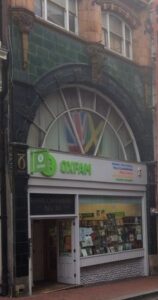We have a copy of the original Pevsner for Berkshire (1966). It is not one of the best in the series. Firstly, it was mostly written soon after his wife’s death and his heart was perhaps not in the work. Secondly, Pevsner had a blind spot when it came to Victorian and Edwardian architecture, and this means that he didn’t really get Reading (the volume is dominated by Windsor), and many of the architectural splendours of the town passed him by.
Yes, reader, they exist. I’ll provide two examples, quoting from the new edition (2010), revised and expanded by Geoffrey Tyack and Simon Bradley. The Board School in Swansea Road ‘with upswept gables and a jaunty onion dome’, and the ‘pretty Art Nouveau in bright terracotta’ at 8 (the number is sinuously rendered on pilasters outside) High St. (I recall the latter as a health food shop and the only place in Reading where you could get natural yoghurt.)
Not for nothing did Hardy rename Reading ‘Aldbrickham’. To its builders, a house wall or gable end was a canvas, and polychrome patterns in contrasting bricks zigzag their way across quite workaday terraced houses. In their way they are just as much folk art as any embroidered peasant blouse.
The geographical ambit of this volume encompasses those bits of the county officially lost to Oxfordshire, such as the Uffington White Horse and Abingdon, and the new edition of course includes much (of varying merit) that is more recent than the mid-1960s. It is far longer than the original edition (812 pp., up from 357 shorter ones) and has 123 colour photographs. There is some entertainment value in comparing entries in the two editions for buildings one knows, particularly on matters of opinion; for example the ‘rather terrible’ St Mary’s Burghfield has become ‘highly eccentric’. It is a shame that Reading did not return the compliment paid to it in the new version by selling copies of it; the only remaining substantial bookshop there (Waterstone’s) did not stock a Berkshire Pevsner and I had to order it online.

